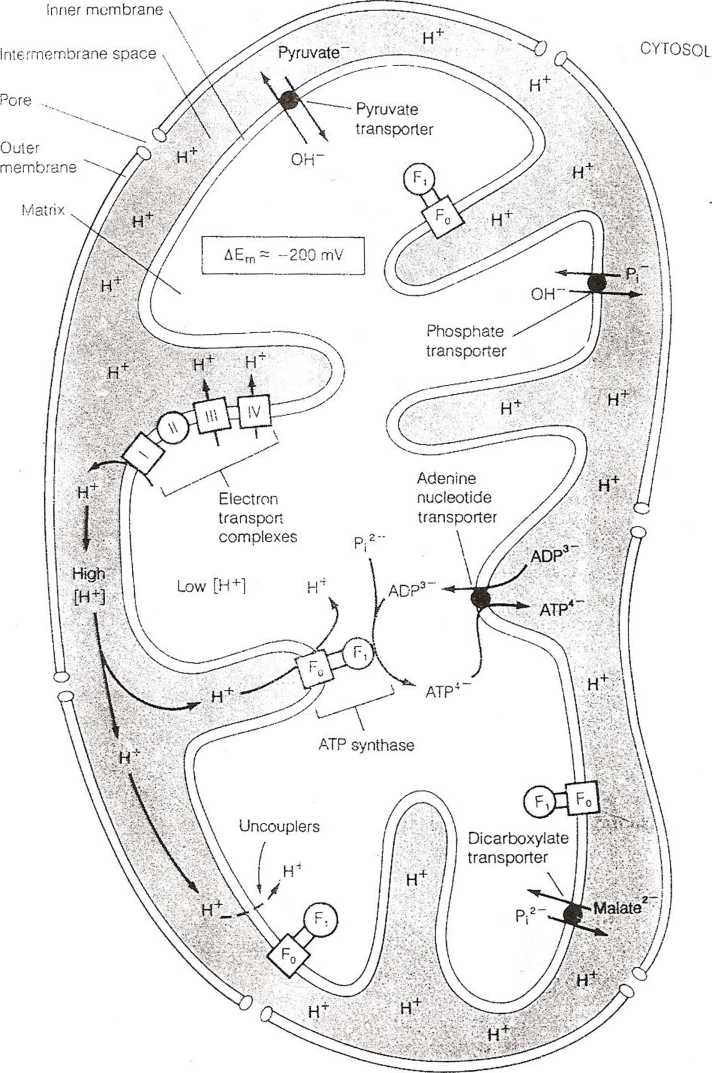54481 skanuj0025 (158)
276 CUAITKR II: Ki-.SIMRATION AND ! Il’ll> MKTAT.Oi ISM

FIGURĘ 11.7. A proton electrochemica! gradient {A/7H =) is established across the inner mitochondrial mernbrane (acidic outside) during electron transport as outlined in the text. The membranę potential component (A£m) cl ihe gradient drives the eiectrogenic exchange of AGP in the cytosoi for ATP in the mitochondria via the adenine nucleotide transporter, and the ApK drives ihe electroneutrai uptake of P, through the phosphate transporter. The free energy stored in the proton gradient is then coupled to the synthesis of ATP from AGP and P. via the many F0F,-ATP syntnase comp!exes that linę the inner mernbrane. The Fc component forms a channel for the movement of protons across the inner mernbrane. while the F, complex provides the catalytic sile for the condensation of AGP and P. to ATP Unccupiers provide a pathway for movement of protons across the inner mernbrane, preventing the buhdup of the proton electrochemical gradient and inhibiting ATP synthesis but not electron transfer {Modified from Oouce. iSS5T
consisrs of rwo major componcnts, Fj and Flt (Fig. 11.7). Ft is a peripheral membranę protein compIex that is com-posed of ar least hve differenr subunits and conrains the catalytic siec for converting ADP and P; to ATP (or hydrol y/.ing ATP to ADP and Pj when the ATPase actmry is be mg mcasnred). This complex is attached to the ma-trix side of the inner membranę. P„ is an integral membranę protein complex that consists of at least three different polypeptides that form the channel through which protons are able to cross the inner mernbrane. The passage of protons through the channel aetivates the
A 1 i5 synrhase to synthesize Al P and simuhaneously dis-sipates the AThe structuie and function of the mitochondrial ATP svnthase are similar to those of the CP0-(.T, A l Pasę in photosynihetie phorophosphoryla-tion (Chapter 8).
Aceeptanee ot the generał features of a chemios-motie mechanism ol A FP syitthesis has sevcral tmjni-cations. First, the truć site of ATP formation on the mitochondrial inner membranę is the ATP s\ nthase com-plex, not complex 1, 111, or IV. The larter serve as siics of energy consenuition whereby electron transport is
Wyszukiwarka
Podobne podstrony:
65062 skanuj0025 (90) 276 CIIAITFR II: RF.SRIRATION AND 1.11 ID MKTAROI.ISM FIGURĘ 11.7. A proton el
skanuj0008 (432) A [ c <u > i Oj
skanuj0008 (432) A [ c <u > i Oj
kardio12 ii Ki- f.f<edstawior>ym zapisie e*£ widoczna jest stymulacje *.v trybie. t V v •
tH64328 (4) ii: 4
skanuj0053 (58) 1 OK Arkusze kalkulacyjni Ki««toi wykitiów • Kiok 114 • Typ wykrotu ii.mtilniikiwo t
84085 skanuj0008 (367) KflBP Ąo(ćt Ki (9 w ii <? 58 A M ‘ I i? i iki
85853 skanuj0021 (276) 62 II. OD POCZĄTKÓW — DO UPADKU POWSTANIA mantyczności przywiązujemy inne jak
skanuj0010 (274) -i li~ -«r II i* -iSM W 0 a) O&Sz&uiąz cząsteczkami jakoczasSó M’ Oóćśshąąz
więcej podobnych podstron